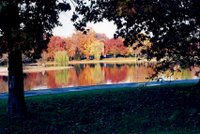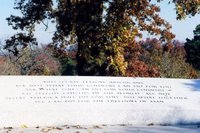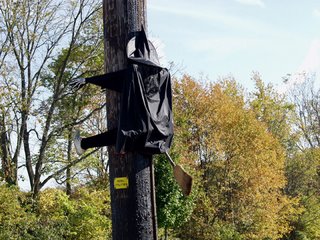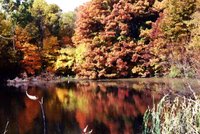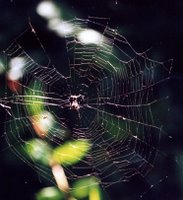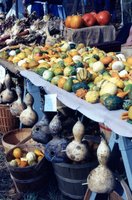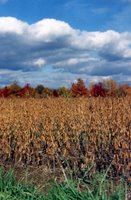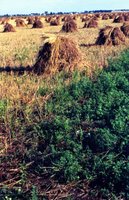The industries of the township were limited in number . There were two or three saw mills located in the southern part of the township on the creeks. The principal industries toward the latter part of the 1800's were located in the northern part of the township in South Peru. Orlando and Heney Mosley, located in the southwesern part of the township, on Strawtown Pike, having created some industry. Orlando has a large machine shop to manufacture fence machines and do general repairing. Henry has for some time operated a large cider mill and jelly factory, and has recently constructed a large sorghum factory with the latest improved apparatus. The Maris wheel manufactory was started in South Peru in 1871. S. Tudor & Co.'s packing house was established about fifteen year ago. This house engages extensively in packing eggs, butter and poultry for a wholesale house in New York City.
Besides the above industries , there was John Miller's blacksmith shop and wagon works, Lewis' saw mill, for many years the largest in the county. Kuntz & Demuth's planing mill, and the Peru Brewery were also residents of South Peru.
note: Most of the industries mentioned are now part of history-however, Peru Brewery is going strong but is now called Cole Bros. water. Who would have ever thought we would be buying bottles of water instead of beer?
Saturday, December 30, 2006
Wednesday, December 27, 2006
Indian Burials
In the early history of the county, Henry Howes, a pioneer, was probably more familiar with the Indians than many others. When a young man he often went to the Indian Village near Denver. Peashwah and Weasaw and many other Indians were converted by Catholic missionsaries before there were any settlers here. The priest was not with them often, but they always met on Sundays in an appointed place and observed the Catholic form of worship. Each converted Indian had his rosary, and no doubt, while brooding over the enroachments of the whites, performed his vigils.
It is interesting to know how the Indians buried their dead. They wound the body in a blanket and stood it upright on the ground. They drove pickets around the body and then wove bark between the pickets so as to make the grave perfectly closed and tight. If the Indian had smoked they would put a pipe and tobacco in the grave, and always what provisions they supposed would last him until he would reach his happy hunting ground. There were many graves like this near the Indian village in 1834. They began to bury as the whites soon after the settlers arrived.
It is interesting to know how the Indians buried their dead. They wound the body in a blanket and stood it upright on the ground. They drove pickets around the body and then wove bark between the pickets so as to make the grave perfectly closed and tight. If the Indian had smoked they would put a pipe and tobacco in the grave, and always what provisions they supposed would last him until he would reach his happy hunting ground. There were many graves like this near the Indian village in 1834. They began to bury as the whites soon after the settlers arrived.
Friday, December 22, 2006
Wednesday, December 20, 2006
Haunted House

1899--The "haunted" brick house at the northeast corner of East Main and Water streets, where the Sargent grocery now stands, was torn down about this time. The liveliest set of spooks that ever wandered about at the midnight hour went in and out of that house and its reputation as an abiding place of uneasy "spirits" gave it such a name that it could not be rented for years, and many people living east of it traveled other streets to get to their homes after night. Only a comparatively few residents knew the secret of the "ghosts" and they didn't tell. Some are yet living in Peru who could probably explain the matter, and we suggest that if anybody wants to know they interview Eugene Jamison of the fire department or Chris Bolsman of the street department. We suspect tht they can explain it. Gee, makes me wonder if there was a murder or something of that nature that made the spirits stick around.
Monday, December 18, 2006
My Christmas Wish


To wish you love that will shine serenely through all the days of your life
To wish you boundless Christmas love that we share with one another
To wish you peace in this Christmas season
To wish that your heart be filled with joy and gladness
To wish that you remember those that are lonely
To wish that you may see all the beauty in the world
To wish not for material gifts, but lasting gifts such as Time
To wish that you will remember why we celebrate this season
To wish that you will remember our service men when you pray
To wish that all the paths you may walk be lit with God's unconditional love
Merry Christmas to all of you from Peru Then and Now
Saturday, December 16, 2006
Generations of Yesterday
I have an insatiable curiosity about the generations before us. I want to know what it was like for them to travel across the country--to settle in a new place--and what their personalities were. I have worked on geneology for several years. It is a never-ending task because children grow up, marry, have children of their own, and the older generation dies.
In writing of the history of Peru, I talk to a lot of people about their grandparents and great grandparents to see if they were among the early settlers that helped form this community. I started with my classmates, the class of '59, to see how many settled in the early years of the town of Peru.
I have been quite surprised at what I am finding. James Sharp settled in Washington township in the 1840's --his descendent Becky Dawalt Powell. Samuel Phillabaum settled in Erie township. One of the early schools was built on his land--descendent Nancy Phillabaum McConnaughey. Michael Costin was known for his ability to move just about anything--his descendent Mary Costin. Della Donaldson McKee and Diana Donaldson's grandfather Fletcher was a blacksmith and their other grandfather Oscar Donaldson worked on one of the many railroads that came through Peru and also had a farm on 31 that no longer exists. My great-grandfather owned a flour mill that set on Bayless Street. I will keep searching !!
In writing of the history of Peru, I talk to a lot of people about their grandparents and great grandparents to see if they were among the early settlers that helped form this community. I started with my classmates, the class of '59, to see how many settled in the early years of the town of Peru.
I have been quite surprised at what I am finding. James Sharp settled in Washington township in the 1840's --his descendent Becky Dawalt Powell. Samuel Phillabaum settled in Erie township. One of the early schools was built on his land--descendent Nancy Phillabaum McConnaughey. Michael Costin was known for his ability to move just about anything--his descendent Mary Costin. Della Donaldson McKee and Diana Donaldson's grandfather Fletcher was a blacksmith and their other grandfather Oscar Donaldson worked on one of the many railroads that came through Peru and also had a farm on 31 that no longer exists. My great-grandfather owned a flour mill that set on Bayless Street. I will keep searching !!
Thursday, December 14, 2006
Washington Township
It would seem that the organizers of the township were very patriotic, giving the township the name of Washington.
From early records Thomas Hinton was the first white man to make permanent settlement in the township. He located in 1838, on what is now the Demuth farm. Hinton was a bold, energetic young man. He soon erected a rude log cabin, in which he lodged, drawing largely upon the wild game with which the forests abounded for his food. Some years later he resigned the life of bachelor and married. In 1839, immigration came to the township, bringing a number of stalwart fearless men. The first church in the township was built on the farm of Mr. Crider, in 1857, by the United Brethren and known as "Crider Chapel". Another was built about the same time by the Presbyterians on the White farm known as "New Hope Church". The first school of the township was taught in the small cabin that had been built for a dwelling on the land of John Allen in the winter of 1842-43. The fall of 1843, a small round log school house was built on the farm of Patrick Colgan. The same year, a small "buckeye"cabin for school purposes was built on the on the farm of Peter Wickler. The township has grown considerably since the early days of the pioneers.
From early records Thomas Hinton was the first white man to make permanent settlement in the township. He located in 1838, on what is now the Demuth farm. Hinton was a bold, energetic young man. He soon erected a rude log cabin, in which he lodged, drawing largely upon the wild game with which the forests abounded for his food. Some years later he resigned the life of bachelor and married. In 1839, immigration came to the township, bringing a number of stalwart fearless men. The first church in the township was built on the farm of Mr. Crider, in 1857, by the United Brethren and known as "Crider Chapel". Another was built about the same time by the Presbyterians on the White farm known as "New Hope Church". The first school of the township was taught in the small cabin that had been built for a dwelling on the land of John Allen in the winter of 1842-43. The fall of 1843, a small round log school house was built on the farm of Patrick Colgan. The same year, a small "buckeye"cabin for school purposes was built on the on the farm of Peter Wickler. The township has grown considerably since the early days of the pioneers.
Tuesday, December 12, 2006
Iliff Grocery


Another in our series of "mom & pop" grocery stores--Iliff Grocery was located at the corner of East 6th St.and Water St. The owner was Paul Iliff, of 267 East Eighth Street who became a Peru Policeman at the age of 30. In the late 1930's Paul bought a little pup for his daughter Patricia to play with. It nipped her while playing in the store, so she picked the pup up and gave him a good hard bite. He went yelping under the counter and hasn't tried biting her since. Wonder what the health department would think if they were to walk into a grocery now and see a little girl playing with a puppy.
Paul also maintained a delivery truck for his business. Pictured is his daughter, Patricia, on the running board of the delivery truck. I know older patrons would appreciate that service today-- order your groceries on the phone and have them delivered to your home. Modern technology is not always better. People like Paul believed in customer service.
Monday, December 11, 2006
Fletcher Blacksmithing
There is an art in everything and it is important in shoeing a horse that only those who are skilled in the art be employed. It is not only a matter of economy that this work should be well done but it is also necessary for the comfort and good condition of the animal. In Mr. John W. Fletcher we find a man who is expertly skilled in all the detail of the art and his new shop in a specially constructed brick building at 11 East Second street has everything in the way of tools and machinery necessary for successfully presenting his business of horse shoeing, general blacksmithing and wood working. This is a business which Mr. Fletcher thoroughy understands and it will pay anyone to inspect his shop, which is a model of mechanical appliances. Mr. Fletcher has procured the services of Mr. Souther, who is informed on all matters pertaining to a horse's foot and who has the reputation of being one of the best shoers in the state, and this department of Mr. Fletcher's business is constantly growing in populartiy.
Friday, December 08, 2006
Amusements in Peru
It is always interesting to learn of the manners and customs of proceeding generations. The early settlers farmed mostly with oxen. Families went to church, to parties or visiting on foot, or else hitched the oxen to a big, heavy wagon. Many men went to church bare-footed. In summer their dress consisted of a hat, shirt, a pair of pants, with string or linne bark suspenders. Their amusements were nearly always associated with labor. They enjoyed log rolling. They sat around great heaps of logs in the evening, stirred the logs together and told huge stories. At corn huskings all the young folks of the neighborhood gathered and with their labor enjoyed music and stories. The ladies had their quilting, carpet rag and spinning parties. The men had wood choppings, and in the evening the largest room was cleared and all engaged in a big dance. Shooting matches were a great place for fun. The best marksman was the hero of the county. There was always something to eat and drink. The settlers also enjoyed hunting parties. It was very commom for neighbors to help raise barns. The men worked all day and were rewarded at the end of the day--the women cooked a huge meal for their labors. Can you imagine the kids of today thinking it would be fun to go to a barn-raising and have to work all day?
Monday, December 04, 2006
Benoma Nash

In the death of Benoma Nash at his home in Erie townsip on May 8, 1908, Miami county lost one of its prosperous and energetic citizens, a man who had spent all his life in this section of Indiana, was an industrious and capable agriculturist, and made a creditable and honorable record in all his transactions and relations with his fellow men. He leaves a widow, Mrs. Jessie Nash, and a family of children and Mrs. Nash has proved herself a capable manager of the fine farm estate on which Mr. Nash spent his latter years. Benoma Nash was the son of Robert and Ruhanma (Styers) Nash. In 1898 they settled on the farm in Erie township of Miami County, where Mr. Nash died. Mr. Nash had two hundred and forty acres in the homestead, and in 1913, Mrs. Nash purcased 118 acres and the total acreage is three hundred and fifty-eight acres of land.
The late Mr. Nash was a member of the Quaker faith. He served as superintendent of the dredging work in this section of the state, and was a progressive citizen who believed in development and improvement along all lines. At different times he used his efforts to get telephone service to his district, and was the type of citizen whose activities and influence count
for a great deal in the advancement of a county. Mrs. Nash maintained a modern home, fitted with all modern equipment, and is known as "Locust Crest," the abode of hospitality.
Wednesday, November 29, 2006
Kalbfleisch Sanitarium

Dr. Kalbfleish was born in St. Louis, being of German parentage. When he took up the study of medicine he abandoned the lifework which had been marked out for him previously, which destined him for the profession of minister in the Lutheran church. Following a year's post-graduate work in Chicago, Dr. Kalbfleisch located at Peru, and this has been his permanent residence ever since. In 1900 he erected his Sanitarium in this city, which was designed in the first place to accommodate his own large private practice. This is a two story brick building 78x26 in ground dimensions, and is equipped with the most modern appliances and conveniences for sanitarium and hospital practice. Immediately upon its completion, Dr. Kalbfleisch extended the use of his building to other members of the profession and thus to a large degree it has served the purposes of a general hospital. Though he is a graduate of the Hahnemann School of Medicine, he is not dogmatic in his devotion to the principles of homeopathy, and practices any system that offers the best results for the individual patient.
Note: When I was small Dr. Barnett had his practice in this building In 2006, it is now called the
Farris Wheel--an antique store.
Tuesday, November 28, 2006
Richard H. Cole
Richard Cole, of the Miami County Sentinel and one of the proprietors of the Cole Block, was born in this city, Nov. 26, 1853: son of Hon. Alphonso and Sarah (Henton) Cole, and is of English extraction. His father was born near Oberlin, Ohio in 1818. He came to Miami County in 1834. By occupation he was a lawyer and one of the early member of the Miami County Bar. In 1847 and '48 and '50, he represented this county in the Indiana Legislature. He was one of the early prominent men of this county. His death occurred in 1862. Our subject is the elder of two living children. After graduating at Peru High School, he was a student for two years at the University of Illinois. In 1876 he was elected Surveyor of Miami County, and in 1881 was elected City Engineer of Peru. In 1879 he purchased a half interest in the Miami County Sentinel, and with which he is now connected. In politics he is a Democrat. He was married in 1882 to Miss Belle Talbot, of this city, born in 1860. Mr. Cole is a representative of one of the early families of this county.
Saturday, November 25, 2006
Saloon Incident
1905--A man from Wabash came to Peru Saturday evening and proceeded to the saloon near the steel mill where the bar-keeper seriously disfigured the visitor's face with the use of a beer bottle. The saloon-keeper claimed that the Wabash man had been too familiar with his wife. The injured man went to the office of Dr. Malsbury where he had his wounds dressed.
So much for a Saturday night beer!
So much for a Saturday night beer!
Thursday, November 23, 2006
Count Your Blessings

To all Peru Then and Now readers best wishes for a Happy Thanksgiving!
1885--Rev. L.P Marshall--If we turn unto the Lord, and consider his ways, and walk therein, we shall find peace and safety.The true reason for our thanksgiving will be found therefore along the path that indicates the presence of God's Spirit among us.
Count your blessings one by one and have a wonderful day!
Wednesday, November 22, 2006
Fox Hunt
1905-- There will be a fox drive given by the farmers in the vicinity of Paw Paw next Saturday. The ladies'aid society of the Paw Paw church will serve a dinner and there will be amusements of all kinds to interest those who attend. These gatherings are good things in so much as they bring the farmers together to enjoy a day at a season of the year when not busy. A number of Peruvians will doubtless join in the chase. --Tally Ho!!
Monday, November 20, 2006
South Peru School

1900- The town fathers conducted a meeting in 1900 to build a four room brick school with a furnace in the hole in the basement. There were two rooms up, two rooms down, oil lamps, a pump in the basement where each child could pump his or her own water. All eight grades were to be taught here. Outside facilities were the order of the day. Parents brought their children to school in horse and carriage or by horseback. The South Peru community grew with the times. The school built inside facilities, a basement underneath the whole building was dug out and an auditorium was built. A kitchen, a storage and furnace room was also built. Gas lights and water fountains were installed by the end of World War I in 1919. By the end of the Second World War, the school had electric lights, two globes for each room, radios for each room, a large phonograph for the building and the school lawn landscaped with grass in front, rather than a mud hole.
During the Korean War indirect lighting was added, shades and electric clocks were installed. A small inside bell was used through the 1950's. The South Peru School became so crowded that plans were made to build a new school overlooking the park. November 17, 1957, the cornerstone was laid for the new school. In 2006, a grocery store has replaced the old South Peru School.
Saturday, November 18, 2006
Goat Antics

Kokomo Tribune-1870 A goat owned by an Irishman in Peru ate up $70. in greenbacks. The owner gave him a pounding and a bottle of castor oil, but he did not get his money back. That was a dead loss.
Whoever goes to Sam Stern & Co.'s Grocery, east side of the square, for eatables gets his money's worth and no mistake. No dead loss about that but a big gain. Try it.
Thursday, November 16, 2006
Canning Factory

1905--The canning factory in Peru is an assured fact. We hear that the farmers in this vicinity have agreed to raise the required acreage of sweet corn and some of our enterprising capitalists have put all the money into the concern necessary to make it a certainty and a success.
note: the picture is of the Stokely Van Camp canning factory in Oakdale.
Monday, November 13, 2006
Photos from Washington

Have been in Washington&Maryland the past five days to welcome a new great grand-daughter into the world. She is a little bundle of rosy cheeks and very blue eyes. We spent time in Washington sightseeing, being surrounded by veterans of the many wars. When you arrive at Arlington it is overwhelming to see all the polished white stones--row after row--and then you realize that they were someone's father, brother, or son. While at the Vietnam Wall there were thousands of people looking for the names of their loved ones. Michael Miller and Thomas Grimes from Peru are names we found. I was watching some of the people while there--I observed a young man--confined to a wheelchair with no legs--a casualty of Iraq. A WWII veteran walked up to the young man shook his hand, thanked him for his sacrifice, and then gave him a hug. I brushed away a tear. I wish nations could put their differences aside and live in peace. I don't want to see my great granddaughter grow up in a world of turmoil.
Tuesday, November 07, 2006
Central School

Before the early 1860's opportunity for education was limited. Funds became available through the state so the city took advantage of the opportunity for free schools. In 1860 Central School building was erected on the corner of West Sixth and Miami streets at a cost of $15,000.The most memorable fact with the opening of the school was that it was on the same day that Abraham Lincoln was inaugurated President of the United States.
Central School was abandoned when the city leased a building at the corner of Broadway and West Sixth Street. The abandoned building was demolished in 1910 to make way for the new Peru High School.
Saturday, November 04, 2006
SQ Mascot

Mrs. Jesse Steiner worked at Sq D Peru for 21 years. Jesse had a dog by the name of Brownie who would follow her to work everyday. She let Brownie watch her punch in and out and the dog would hang around all day waiting for her to leave work. Jesse left the Peru Plant due to ill health in 1949. Brownie continued coming to the plant everyday. Just before 7 a.m. he would be at the time clock, at the noon buzzer, and at quitting time. Workers at the plant believed you could set your watch by him.
The Peru Oldtimers decided that Brownie should be rewarded for his faithfulness. So, adding his mistress' service of twenty-one years--to Brownies four--they bestowed a twenty-five year pin to Brownie. What kind of dog was Brownie?? I believe they call it a heinz 57.
SQ D- Schneider Electric

Sq D Peru, was the recipient of IndustryWeek Best Plant 2006. The criteria for winning an award of this caliber is based on inventory management, high regard for safety, productivity, and serving the customer. Over two hundred industries were nominated for this award. Of the top ten, three were from Indiana. In 2005 the Peru Plant acheived a 97% on-time delivery.
Sq D started in Peru in 1920 making porcelain bases for safety switches. Through the years many changes have been made to better serve their customers.
Of a personal note: I retired in 2005 after working twenty-six years. The job provided a good living, many challenges, an appreciation for safety, and fellow workers who became friends. Congratulations to all who made this award possible!!
Thursday, November 02, 2006
Boston Store

1905--This celebration devoid of fuss or flourish, will focus the attention of all the people of Peru and Miami County. We invite you to participate in this important event. Come in to our store with the welcome and freedom of old friends.
Our mission is broad, our aims will constantly be bent toward the best service to the public, and satisfaction to all.
We have leased the Sullivan Building at No. 59 N. Broadway for several years, and with your help we will try to make this store the people's most popular trading place in Peru. We will carry a full line of Dry Goods, Millinery, Ladies' Furnishings, Queensware, and a full line of Household goods.
The Boston store was later moved to South Broadway where the Post Office stands now-2006.
Wednesday, November 01, 2006
Coal Famine
1905--There came near being a coal famine in Peru during the past week, The supply of all the dealers was exhausted Friday and but for the arrival of three car loads on Saturday there would have been some cold stoves in Peru homes. The dealers have since received a shipment and the majority of them are supplied.
Aren't we glad we don't have to shovel coal to warm our homes? I can remember a few times that I had to do that. I prefer to walk to my thermostat and turn it up a little as opposed to shoveling coal and having to get rid of the klinkers. How about you?
.
Aren't we glad we don't have to shovel coal to warm our homes? I can remember a few times that I had to do that. I prefer to walk to my thermostat and turn it up a little as opposed to shoveling coal and having to get rid of the klinkers. How about you?
.
Monday, October 30, 2006
Chicken Thief

1905-Two officers of the Cass county detective assoc. accompanied by a member of the Logansport police were in Peru and took into charge C.H. Miller. Miller hired a horse and wagon and drove to the homes of Edward Kirkpatrick, Lewis Hertzell and John Zimmerman. He loaded up four dozen chickens and four turkeys belonging to these men and drove to Peru where he sold his product at the Peru packing house. He received $23.09 for the lot and straightway began to spend the money in some of the numerous saloons on South Broadway. He was in a candy store at 117 South Broadway when found by Sheriff Skinner and Officer O'Brien. He had $21 of the spoils in his pocket and his rig was located at the Davidson barn. At first he denied his guilt but before being taken back on the noon car, he confessed and now he will await a sentence of the Cass county court, which will doubtless place him in the Southern reformatory for a few years.
Saturday, October 28, 2006
Peru Retail Grocery
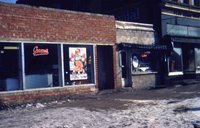
The Peru Retail Grocery was owned by Robert Geberin. Bob started in the grocery business when he was sixteen at Lett's Grocery in Bunker Hill. He worked 50 to 60 hours a week receiving a paycheck of $12.00. Bob married Juanita Long and eventually moved to Peru from Bunker Hill.
Bob changed jobs working for Palmer & Ditzler Locker Plant. During the war he worked at Riggles' machine shop but his love for the grocery business prompted him to return. He maintained the Peru Retail Grocery in a building on North Broadway in 1948. A few years later Bob then built his business at 167 North Broadway next to the old Y.M.C.A.
Our dad, Bob Geberin, built an apartment on the back of the lot, then proceeded building his own new store. He then built an apartment above the grocery which gave us a high-view of Broadway. The" Cozy Nook," a restaurant with good home cooking, was also added (my mom's cooking). I still picture my dad grinding meat to make hamburger. Like other mom & pop groceries people ran "tabs" and would pay at the end of the week. Eventually he bought Squirrel Food Co. which dealt in restaurant supplies. Bob serviced Peru and surrounding communities.
Friday, October 27, 2006
Richard & Joan Wylie


Dick and Joan Wylie were in Peru this week traveling with a church group from California. They were enjoying Hoosier Hospitality to its fullest.
Dick was pastor of the First Presbyterian Church in Peru from 1968 to 1981. Their children went to Peru Schools during that time--Steve, Carol and Janet.
I have many fond memories of their family. We used to have church campouts on the Eel River once a year. Those that loved to camp joined in the Christian Fellowship fun. One such year the men decided to have a style show. Dick replaced his white shirt, tie, trousers, and robe for a very elegant creation that would have envied Lauren or Dior. The laughter echoed throughout the campground all the way down the river. Also, I question his ability to navigate the river as the canoe he was in charge of tipped in the water with my youngest daughter aboard. Dripping wet they finally made their way back to camp. Memories I have of Dick--full of compassion, warm & caring, very knowledgable of Peru History, reaching out in the community, and was an excellent minister.
I don't know how Joan does it--she looks the same as she did back in 1968. Unbelievable!
We miss you, Richard Wylie, former minister of First Presbyterian.
Tuesday, October 24, 2006
Fire Destroys Grocery


1957--Fire destroyed Clem Toepfer Grocery and Purvis Drugstore. Also damaged were Roy's Tavern, A.G.P. Corporation and apartments. The fire was first discovered in an attached shed behind the tavern. Flames shot as high as 30 feet.Fire chief Burrous thought it was one of the worst fires since the burning of the Thrush factory five years ago. Fortunately, no one living in the apartments was injured.
Mr. Toepfer decided to rebuild his store and continue serving his customers. The store was rebuilt in 1958. He continued his business until 1967. Dedicated men like Clem Toepfer are a rare breed. The children loved him and he became friends with many of his customers. Today's supermarkets lack that warm atmosphere of the old "mom & pop" groceries that were present back in the 40's to the 70's.
When i was a kid I can remember going into Fisher's Grocery close to my house. I still can remember the old pot belly stove that gave warmth to the building. My father also was in the grocery business on North Broadway. Some of these buildings are still standing but deserted. Others have been torn down. The children of today have missed the experience of these "mom & pop" groceries where you could spend lots of time picking out your favorite penny candy.
Monday, October 23, 2006
Toepfer's Grocery 1933-1967
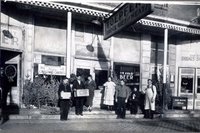

In 1929, Clem Toepfer operated a grocery store in South Peru. In 1933, he moved his business to 316 West Main Street.
As with a lot of "mom & pop" grocery stores you could call on the phone and your groceries would be delivered. His two daughters named his delivery truck "Rattle Trap" because you could hear it coming down the street. Most customers would run a "tab" and pay their bills weekly or monthly. Clem was well-known for his homemade mincement much to the delight of holiday bakers. Very few people had freezers so customers would order meat and produce several times a week.
Clem had a wonderful sense of humor, was quick-witted, and the life of a party. Children loved him and gave him the name "Clem Kadiddlehopper". Clem's father, born in Germany, was a blacksmith and became partners with John Volpert. The business was known as Toepfer & Volpert.
A fire destroyed the business in 1957 but was rebuilt and continued serving customers until 1967. From 1968 to 1990 Clem was associated with Peru Federal Savings and Loan. Note: a car wash now stands in the location of Toepfer's Grocery in 2006.
Sunday, October 22, 2006
Peru Courthouses
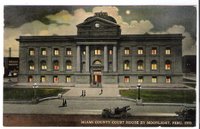
Peru's first courthouse was built in 1843. It was a two story brick building 40 feet square, in the Greek Revival style of architecture. It had tall white pillars reaching to the roof and a cupola with a weather vane on top. There was a fireplace in each room. On the night of March 16, 1843, it was destroyed by fire. Most of the county records were destroyed.
In 1856 a new courthouse was begun. It was a two-story building, which was of brick in the Norman Style of architecture, was completed in 1858.
By 1905 the second courthouse had grown too small to accomodate the county's business. The building was blown up. The front of this courthouse faced South.
Work then began on the third courthouse which is standing today-2006. The building was completed December 31, 1910 but was not dedicated until 1911.
A special note: In between the burning of the first courthouse and the building of the second court business was conducted in the Presbyterian Church that was located in the first block of West Third Street.
Thursday, October 19, 2006
Okie Pinokie-Haunted ?????

Ghosts are often depicted as human size and shape but it supposedly is like looking through a sheer curtain --nothing solid. They seem to float in mid air. Some people believe ghosts wander aimlessly because they were not able to rest or see the light.
All those people that are fascinated by ghostly things will probably be going out to Okie Pinokie within the next two weeks since it is getting close to Halloween.It is quite interesting to read of people's experiences of going to this place at night.According to the urban legend eight bodies
have been found there. At one time Indians roamed those woods and probably lived in that vicinity. Where do you think they were buried? It is a long narrow lane to get there and yes, it would be very scary at night because it would be very dark with the trees overhanging on the road. If you are brave enough to go there take plenty of flashlights and good luck.
Monday, October 16, 2006
Elbert Shirk
Elbert Hamilton Shirk was born in Franklin Co., Indiana in 1818. Mr. Shirk arrived in Peru the summer of 1844 and formed a business with John Harlan in the mercantile business. He married Mary Wright, of Franklin County, in 1845. She was a lady of English descent, who returned with her young husband to the new and strange home in Peru. They brought all their goods in a two-horse wagon. A year later the firm of Harlan & Shirk was dissoved and Mr. Shirk continued the business alone. He was very successful as a merchant and accumulated wealth very rapidly. From 1850 to 1855 he invested largely in Mexican war land warrants, which he laid judiciously in Iowa and other western States, which in turn were exchanged for improved farms in Miami County. This was the beginning of operations in real estate which laid the foundation for a colossal fortune. Under the national banking act Mr. Shirk procured a charter and proceeded to organize the First National Bank of Peru. Mr. Shirk was of medium height, erect and quite slender. His life was clean and free from vicious habits. He was therefore clear headed; able to utilize all his tremendous energy, and accomplished the purpose of his will. He was a true example of a successful self-made man. He was the wealthiest man in northern Indiana, and one of the wealthiest in Indiana.
Joseph Holman
Joseph Holman was a name familiar to all the early residents of Peru. He was a native of Kentucky. Mr. Holman purchased a tract of 640 acres of land on the Wabash, upon the eastern half of which the original plat of Peru was subsequently laid out by William Hood. Mr. Holman traded extensively in lands and all kinds of real estate and was prominently associated with the early growth of Peru and Miami County. In about the year 1839 he disposed of his interests in Miami County and returned to Wayne County, where his death occurred in 1872. He was instrumental in founding Miamisport. Eventually, Miamisport became Peru.
Friday, October 13, 2006
Wednesday, October 11, 2006
Gabriel Godfroy

August 15, 1910--Gabriel Godfroy chief of the Miami Indians, died at his home four miles southeast of Peru last Sunday. Chief Godfroy was seventy-six years of age, being born on January 1, 1834. His father was Chief Francis Godfroy of French descent, who moved his family to the county shortly after the birth of Gabriel. After the death of Frances, Gabriel became chief and devoted his time, energies and money to the interests of his people. Because he was liberal Chief Godfroy became poor. He was called upon scores of times to pay fines, assessed against the Indians for intoxication. For seven years he paid the expense and the stood the worry of a battle with the county commissioners brought to compel him and others of his tribe to pay taxes on their lands. They claimed the lands to be exempt, because of the treaties by which they were deeded to them by the government. Shrewd lawyers took advantage of him and helped to reduce his wealth. Chief Godfroy was married three times and by his three wives he became the father of nineteen children. His short stout figure and his long snow, white hair, made him a picturesque figure.
Tuesday, October 10, 2006
Monday, October 09, 2006
Earthquake in Peru
Oct. 31,1895--A very marked siesmic disturbance was noticed in this city this morning a few minutes after 5 o'clock. There were two shocks ten seconds apart. The earth seemed to vibrate north and south and to one lying in bed the sensation felt like some one had hold of the bed post pulling and pushing with violence. Some people jumped out of bed and ran out of the house. Some ran down into the cellar to see if the gas had exploded and others looked under the bed for burglars. No damage was done other than frightening those who were awake.
Saturday, October 07, 2006
Julius Falk

May 1, 1914--Julius Falk, pioneer merchant, and one of the most widely known citizens of this section of Indiana, died Saturday, at his home on South Fremont Street. (Julius lived prior to that on West Main where Eikenberry Edy is now.) A few years ago he was attacked by paralysis, but he fought a courageous fight. Julius Falk was one of the oldest business men of Peru, in point of years of service on Broadway, but was only sixty-two years of age, a son of Mr. and Mrs. Moses Falk. Falk was a native of Peru and spent his lifetime here, most of it in the clothing and furnishing business. His business was located in the Cole block, corner of Main and Broadway.
Thursday, October 05, 2006
Frank Steinmetz Saloon

Frank Steinmetz, 56 North Grant. Mr. Steinmetz is our popular Grant street saloonist, having been established eighteen months. In the way of stock, the selection is calculated to meet the wants of the most critical tastes, including the finest imported wines, whiskies, brandies, cordials, etc.; also the leading brands of domestic made cigars, while all the noted brands of beer can be obtained here. Mr. Steinmetz is an affable gentleman and has a host of friends, and while in this part of the city do not fail to visit his place.
Tuesday, October 03, 2006
Cole Porter Birthplace Renovation

The Cole Porter Birthplace renovation is moving right along. If you like to paint or pick up a hammer they still could use volunteers even if only for an hour or two. You can find someone there on the weekends if you would like to be part of this renovation. Come --join in--as part of Peru history unfolds.
Frank Deibert, Groceries and Provisions
Frank Deibert, was among the earliest enterprises inagurated in the pioneer days of Peru. The grocery was located at 75 Broadway. This concern was established in the year 1855 by Henry Deibert, who was succeeded by his son, Frank Deibert, in 1872. Much of the gratifying increase of Peru's trade must be attributed to this house on account of its long identity with the trade. The building occupied is spacious and is completely stocked with groceries and provisions of all kinds, which are obtained from the most reliable sources of supply, being alway fresh and seasonable. Mr. Deibert gives his personal attention to every detail of the business , and has five competent assistants, neglecting no means to fully deserve the exceptional popularity his establishment has. This popularity is due to the courtesy extended to the customers and the prompt delivery service.
Saturday, September 30, 2006
Marty Hess
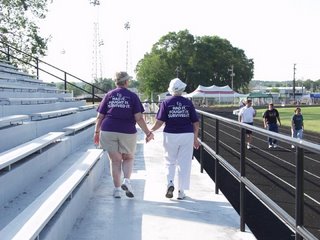
Marty Hess is an elder at the First Presbyterian Church. Marty is a registered nurse and wife of Jack Hess at the Presbyterian Church in Peru. Marty is a breast cancer survivor. Marty is now fighting for her life with acute myelogenous leukemia. The chemo that put the breast cancer into remission has led to this. She is now scheduled for six weeks of intense chemotherapy. My wish is that the community will stand behind Mary and Pastor Jack in prayer. To follow her battle with her disease go to http://martysstruggle.blogspot.com. Please keep her in your prayers. Pictured is Marty Hess and Juanita Geberin.
Friday, September 29, 2006
Lentz Bros.


Have you looked at photos from the flood of 1913 and noticed the name of Lentz Bros. on the photo? This firm consists of gentlemen who are practical artists, and whose love for the picturesque and beautiful exhibits itself in every detail of their work. They excel as artists, and love detail and aim for excellence. Lentz Bros. have kept pace with all improvements in the art, introducing the new and beautiful effects and all advances made. Lentz Bros. were born and raised in Peru and they are the recipients of a liberal and influential patronage. They did an excellent job of capturing the history of our town. The old cliche--a picture is worth a thousand words.
Wednesday, September 27, 2006
American Sylvan Electric Bath No.2
1901--
The bath is a German discovery, protected by American patents, and was introduced into this country toward the close of the year 1899. This is the only one of its kind at present West of Brooklyn, New York. It has curative effects upon Gout in all stages; Muscular and articular Rheumatism in all forms. The bath has also proven itself very efficactous in treating Neuralgia: Nervousness; Muscular Atrophy; Stiffened Joints; Stagnations of the Blood; Asthmatic Complaints; Weakness of the Heart; Paralysis, Diabetes, and other diseases due to disturbed assimilation and circulation of the blood. The Electric Bath was located at 65 North Miami Street and was owned by A.H. Kalbfleisch, M.D. I wonder if this was like our modern day whirpools?
An antique store is open for business at the same address in 2006.

The bath is a German discovery, protected by American patents, and was introduced into this country toward the close of the year 1899. This is the only one of its kind at present West of Brooklyn, New York. It has curative effects upon Gout in all stages; Muscular and articular Rheumatism in all forms. The bath has also proven itself very efficactous in treating Neuralgia: Nervousness; Muscular Atrophy; Stiffened Joints; Stagnations of the Blood; Asthmatic Complaints; Weakness of the Heart; Paralysis, Diabetes, and other diseases due to disturbed assimilation and circulation of the blood. The Electric Bath was located at 65 North Miami Street and was owned by A.H. Kalbfleisch, M.D. I wonder if this was like our modern day whirpools?
An antique store is open for business at the same address in 2006.
Tuesday, September 26, 2006
Bearss Hotel
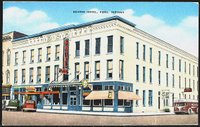
Visitors and a vast number of travelers renders first class hotels an absolute necessity, and by general consent the Bearss Hotel is ranked as the best in the country. The hotel has sixty well furnished rooms available for guests. It is supplied with all modern appliances, electric lights, heated by gas, ladies and gentlemen's parlors elegantly furnished, complete sanitary arrangements, and is fitted in the most modern style of art. The cuisine has a high reputation for excellence. It is so sad this building is no longer in existance. It is nothing more than a pile of rubble hauled off somewhere.. Famous visitors, many memories, and numerous events were all part of the Bearss Hotel. If we could go to the pile of rubble and it could talk --what a tale it would tell.
Sunday, September 24, 2006
Five Corners
Five Corners was a straggling village in the western part of Allen Township, so named on account of its location at the intersection of several roads, and at one time achieved considerable reputation as a trading point. The place was never platted, being merely a thickly settled locality to which the term village can scarcely be applied, but it early on became the chief source of supplies for a large area of territory in Miami and Fulton Counties. About the year 1857, or perhaps earlier, a stock of goods was brought to the place by Moses & Williams, who carried on a very successful business for a period of six or seven years. The business went through a few more owners when L. Carl began merchandising, and continued with fair success for over a year, when he moved his stock of goods to Macy, his store being the last business venture at the Corners. A postoffice was established in 1859, with Nathaniel Bryant as postmaster. The last postmaster was L. Carl, who had charge of the office when it was moved to Macy. The only remnants of the village is Five Corners Cemetery., where lie many of the first settlers of the county.
Saturday, September 23, 2006
Subscribe to:
Posts (Atom)




